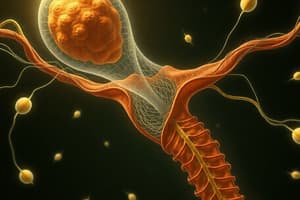Podcast
Questions and Answers
What is the primary role of inhibin in the regulation of spermatogenesis?
What is the primary role of inhibin in the regulation of spermatogenesis?
- Inhibin promotes the production of germ cells by stimulating the pituitary gland.
- Inhibin increases FSH levels, which in turn enhances spermatogenesis.
- Inhibin has no direct effect on the regulation of spermatogenesis.
- Inhibin reduces FSH levels by acting on the pituitary gland's FSH receptors, suppressing the production of germ cells. (correct)
Which of the following is a characteristic of mature spermatozoa?
Which of the following is a characteristic of mature spermatozoa?
- The flagellum, part of the tail, propels the sperm towards the egg. (correct)
- The head contains the energy reserve needed for motility.
- The spermatozoa are immotile until they are ejaculated through sexual intercourse.
- The midpiece contains the genetic material.
What is the role of testosterone in the regulation of spermatogenesis?
What is the role of testosterone in the regulation of spermatogenesis?
- Testosterone plays a negligible role in the regulation of spermatogenesis.
- Testosterone is essential for the development of male sexual characteristics and the maintenance of spermatogenesis. (correct)
- Testosterone suppresses the development of male sexual characteristics.
- Testosterone acts directly on the pituitary gland to stimulate the production of germ cells.
Which of the following is a correct statement about the transformation of spermatids into mature spermatozoa?
Which of the following is a correct statement about the transformation of spermatids into mature spermatozoa?
Which of the following factors can negatively impact spermatogenesis?
Which of the following factors can negatively impact spermatogenesis?
Which part of the spermatozoa contains the genetic material?
Which part of the spermatozoa contains the genetic material?
What is the first stage of spermatogenesis?
What is the first stage of spermatogenesis?
Which cells contain 46 chromosomes during spermatogenesis?
Which cells contain 46 chromosomes during spermatogenesis?
What process reduces the chromosome number from 46 to 23 during spermatogenesis?
What process reduces the chromosome number from 46 to 23 during spermatogenesis?
What is the function of meiosis I in spermatocytes?
What is the function of meiosis I in spermatocytes?
Which cells undergo morphological changes to form round spermatids?
Which cells undergo morphological changes to form round spermatids?
What is the final stage of spermatogenesis?
What is the final stage of spermatogenesis?
Flashcards are hidden until you start studying
Study Notes
Spermatogenesis is the process by which immature sperm cells develop into mature sperm cells within the seminiferous tubules of the testes. It involves four main stages: spermatogonium, spermatocyte, spermatid, and spermatozoa[2,3]. These stages are crucial for producing healthy sperm that can fertilize an egg and result in pregnancy. In this article, we will discuss each stage in detail.
Spermatogonia
The first stage of spermatogenesis begins with diploid spermatogonial stem cells (SSCs), which contain 46 chromosomes. These cells divide through mitosis and produce two identical daughter cells. One cell remains a spermatogonial stem cell, while the other differentiates into a type A spermatogonian (diploid). Type A spermatogonia further divide through mitosis to form two more types: intermediate spermatogonia and primary spermatocytes.
Spermatocytes
Spermatocytes undergo meiosis I division, where they are reduced from 46 to 23 chromosomes. This stage results in two secondary spermatocytes, which divide again during meiosis II, resulting in four haploid round spermatids. Meiosis ensures genetic diversity in offspring by reducing the number of homologous chromosomes that each spermatocyte receives.
Spermatids
Spermatids undergo a series of morphological changes and are known as round spermatids. They lose their cell membrane, condense the cytoplasm into the acrosomal region at the tip of the head, and form a flagellum. The process of maturation continues after meiosis II, with spermatids transforming into mature spermatozoa through further differentiation steps.
Regulation of Spermatogenesis
The regulation of spermatogenesis is influenced by various factors, including hormones and growth factors such as testosterone and inhibin. Testosterone plays an essential role in the development of male sexual characteristics and the maintenance of spermatogenesis. Inhibin reduces FSH levels by acting on the pituitary gland's FSH receptors, suppressing the production of germ cells. Additionally, oxidative stress and inflammation can negatively impact spermatogenesis, leading to infertility issues.
Spermatozoa
Mature spermatozoa have a characteristic structure consisting of three parts: the head, midpiece, and tail. The head contains genetic material, while the midpiece contains the energy reserve needed for motility. The flagellum, part of the tail, propels the sperm towards the egg. Once outside the body, sperm move rapidly toward the egg, potentially after being ejaculated through sexual intercourse.
In conclusion, spermatogenesis is a complex biological process involving several stages that ultimately result in the formation of functional, mature sperm. Understanding these stages and their regulation is essential for maintaining male reproductive health and addressing related conditions such as infertility.
Studying That Suits You
Use AI to generate personalized quizzes and flashcards to suit your learning preferences.




